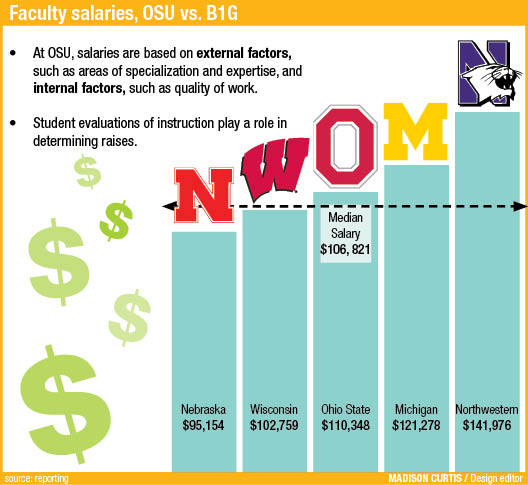Ohio State landed behind a few other conference schools for average faculty salaries during 2012-13, according to a report from the American Association of University Professors.
The report, which computes the average salaries of full-time university faculty in a given institution, showed OSU ranked fifth among the 12 Big Ten universities.
According to the report, OSU’s average weighted faculty salary was just more than $110,000, slightly above the Big Ten median salary of almost $107,000.
A median can be defined as the middle number in a data set and is often different from an average.
Northwestern University, the only private institution in the Big Ten, was first in the conference with an average of nearly $142,000, followed by the University of Michigan, Penn State and University of Illinois.
The University of Nebraska had the lowest average faculty salary, at about $95,000.
There are roughly 2,800 regular faculty members at OSU, according to diversity data from September 2013, compared to about 3,300 full-time faculty at Northwestern, according to its facts website, and about 1,600 general faculty at Nebraska, according to its 2013-14 fact book.
Instead of comparing faculty-wide salaries, OSU philosophy professor Allan Silverman said more accurate salary comparisons could probably be made between departments of various universities.
“Do not be misled by the university-wide numbers. If we have more medical faculty than, say, Purdue, that will skew the compensation figures. A more apt comparison would be to look at, say, the Purdue engineering salaries against the OSU engineering salaries, or Wisconsin history vs. OSU history,” he said in an email.
The Faculty Compensation and Benefits Committee of University Senate helps monitor the state of OSU faculty pay, in part by releasing an annual report to the OSU community outlining its ongoing examination of faculty compensation, retirement benefits, various insurances and other conditions, according to its 2013 Salary and Benefits Report.
This report also includes recommendations for compensation, “based primarily on comparisons of OSU faculty salary data with salary data of established groups of peer institutions, contained in data from the AAUP Faculty Compensation Survey,” according to the report.
OSU spokesman Gary Lewis said OSU faculty salaries are based on a few things, the first being external factors, including areas of specialization and expertise.
“This means that Ohio State tries to be competitive with what other similar institutions are paying faculty members in similar fields,” Lewis said in an email. “Medical schools, for example, share information with each other about their average salaries, and Ohio State keeps that information in mind when recruiting faculty here. It also looks at similar information for different levels of experience.”
The second consideration for determining faculty salaries is internal factors, such as the quality of the work the faculty member does, Lewis said.
Quality of work “includes teaching, designing courses, carrying out research and writing articles and books, giving talks and presentations to other scholarly groups across the country and world, serving on committees, and providing outreach to the community and to his or her scholarly discipline, among others,” Lewis said.
Finally, Lewis said student evaluations of instruction, more commonly called SEIs, play a role in determining faculty raises.
“SEI reports do play a role, as do other student evaluations, since they are typically part of the information that faculty members turn in as part of their annual review materials, which are then used in the annual salary process,” Lewis said.
OSU associate professor of philosophy Timothy Schroeder said, for him, it was more about the people at a school.
“When I was recruited here, the first thing that made me want to come was the colleagues I would have. The philosophy department here includes some internationally famous people doing great work, and the level of research activity and excitement is wonderful. I’ve learned a lot by coming here,” he said.
He added that money isn’t the most important factor in deciding where to work.
“For me, the strongest recruitment pull is usually going to be the chance to work with, and learn from, other philosophers who are really great at what they do. And so, as you can see, I don’t think it’s easy to find a better philosophy department in the Big Ten than Ohio State. Even if I’d had a choice, I wouldn’t now be at Northwestern or Penn State or Purdue,” Schroeder said.
Schroeder said next to the Chicago area, Columbus is, in his opinion, the best Big Ten city to live in.
Associate professor of geography Becky Mansfield said she doesn’t think there is much about OSU that makes it special in relation to the other Big Ten schools, which could possibly make up for pay differentials between OSU and other universities.
Regardless, Mansfield said she was attracted to OSU because of its reputation of being a strong public university, but also said she would probably feel the same about any Big Ten school.
In the end, she said it’s important to note that the job search process in academia is different from other professions.
“When I was applying for jobs and got my position at OSU (this was 2001) there were all of nine positions nationally and only two in the Big Ten. Since then I may have been able to move, but appropriate positions are actually quite rare (especially in my field of geography),” she said in an email.



